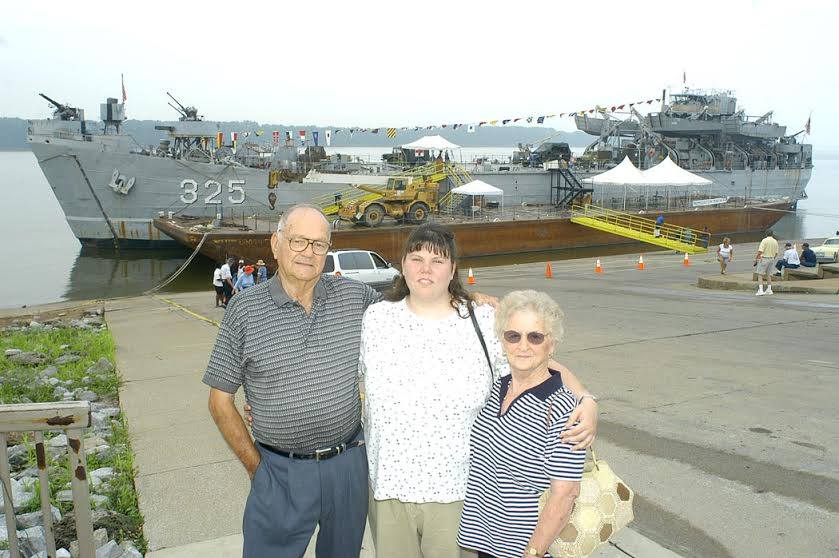While the nation may owe the victory in World War II in part to the amphibious Landing Ship, Tanks (LSTs) that played such a large role in D-Day and other Allied campaigns, I may owe my very existence to one or two of these ships.
Had it not been for my Papaw, Chester Street’s, service on LST-197 in the European Theater and LST-1067 in the Pacific Theater for the duration of the war, my Mimi would have had no reason to exchange letters with him. Those letters budded into romance, and he proposed marriage in one of them, but she didn’t accept until he was home on leave. Following the war they married, and that nearly 65 years of marriage led to five children, seven grandchildren (of whom I am one), 10 great grandchildren and, as of earlier this year, twin great-great granddaughters.
Like so many other World War II veterans, Papaw didn’t talk about his service for decades afterward. It wasn’t until Tom Brokaw’s book, “The Greatest Generation,” came out that he began to tell his family more.
My first efforts to ask questions began with showing him a photo of a person in uniform from the World War II chapter in my world history textbook in college. I asked what the photo was. He told me it was a man in an Italian Army uniform, still easily recognizable to him at that point more than half a century later. He also offered that the sailors he served with had never heard much about Nazi leader Adolf Hitler, instead being told what a monster the Italian fascist leader Benito Mussolini was.
Papaw told me some of the worst of the invasions he had been a part of were the Anzio and Salerno campaigns in Italy, although he also served in three more: Sicily, Casablanca and Normandy, where he spent months ferrying battle-ready troops, tanks and supplies to both Omaha and Utah beaches following the D-Day invasion of June 6, 1944. The names for these places came back to me as I toured the LST-325 for an article in this issue as the LST-325 was in some of the same campaigns.
Chris Donahue, a member of the LST’s board of directors, talked about the difficulty finding crew members for LST-325’s annual cruises, with crew members primarily being in their 70s and younger members desperately needed. These cruises expose people in new areas to the stories of both the LST and of World War II. It is the first time many visitors have heard these stories, either because of the passage of time or because of veterans in their own families who couldn’t bring themselves to talk about painful memories.
I had the chance to tour LST-325 once before, back in 2003, with my Mimi and my Papaw, and other family members, when the ship visited my hometown of Paducah, Ky. The ship was laid out so much like the 197 that Papaw could point to exactly where his own bunk was on the 197. We went into the galley, modernized but in the same space where he once served as ship’s cook 1st class. Papaw talked about butchering the tough Argentinian beef, serving baked beans and cornbread for breakfast every Wednesday and Saturday because that is what there was and the awful powdered milk that led to him enjoying fresh milk at virtually every meal afterward for the rest of his life. There were times he’d like to see what those areas overseas looked like now, he said, but added that he promised himself that if he ever got back on U.S. soil, he’d never leave again. He never did. He died at the age of 89 on February 11, 2011, two days after my son, Drew, turned 1.
When I toured the LST-325 this time, I was able to bring both my husband, Paul, and Drew, now 13, along with me. This time Drew heard the stories that brought to life for him the enormous sacrifices our veterans made for us, including those that I remembered Papaw telling me and that I now told to him. I was grateful for the stories, both new and old. It brought home to me the importance of having vessels like the LST-325 where people can see and touch a part of our nation’s history. Failure to preserve our history all too often means we also fail to remember it and fail to appreciate those who fought and died for our freedom.
I encourage those who have the opportunity to visit LST-325 to do so, and, if not, to visit a nearby museum with exhibits from World War II. Talk about the stories passed down in your family, if you have them. To have heroes for tomorrow, we need to remember those from years gone by. To appreciate the rights we have today, we need to know about those who fought to preserve them back then.
Caption for photo: Author Shelley Byrne (center) with her grandparents Chester Street and Mary Street in front of LST-325 on the Paducah Riverfront in 2003. (Photo by Lance Dennee)




